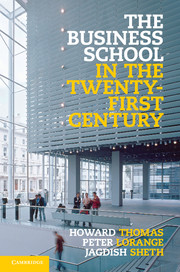Book contents
- Frontmatter
- Contents
- List of figures
- List of tables
- Preface: Tipping or tripping? The business school and its dilemmas
- Acknowledgements
- 1 The business school: history, evolution and the search for legitimacy
- 2 Business school identity and legitimacy: its relationship to the modern university and society
- 3 Rethinking management education and its models: a critical examination of management and management education
- 4 A framework for re-evaluating paradigms of management education
- 5 Evaluating new and innovative models of management education
- 6 Is the business school a professional service firm? Lessons learned
- 7 Enhancing dynamic capabilities in the business school: improving leadership capabilities in curricula and management
- 8 Afterword: business school futures
- Index
- References
6 - Is the business school a professional service firm? Lessons learned
Published online by Cambridge University Press: 05 July 2013
- Frontmatter
- Contents
- List of figures
- List of tables
- Preface: Tipping or tripping? The business school and its dilemmas
- Acknowledgements
- 1 The business school: history, evolution and the search for legitimacy
- 2 Business school identity and legitimacy: its relationship to the modern university and society
- 3 Rethinking management education and its models: a critical examination of management and management education
- 4 A framework for re-evaluating paradigms of management education
- 5 Evaluating new and innovative models of management education
- 6 Is the business school a professional service firm? Lessons learned
- 7 Enhancing dynamic capabilities in the business school: improving leadership capabilities in curricula and management
- 8 Afterword: business school futures
- Index
- References
Summary
This chapter examines the proposition that business schools have simpler characteristics than professional service firms (PSFs). There are two useful reasons for doing so. First, the process of analysing business schools through a professional services lens sheds new light on the management and leadership challenges for business school deans. Second, the process broadens the range of studies of PSFs that exist outside of the ‘core professions’ (law, accountancy, medicine and so on; Lowendahl, 1997), enabling closer scrutiny of the characteristics of PSFs.
Business schools, like most higher education institutions and PSFs, are ‘loosely coupled’ organisations that exhibit a set of distinctive traits and characteristics which lead to a unique organisational form and setting. This presents particular challenges for business school deans since leading a business school is not the same as leading a corporation. In a growing literature that examines business schools and their various constituents, there is only limited coverage of the practice and role of deans (Davies and Thomas, 2009).
- Type
- Chapter
- Information
- The Business School in the Twenty-First CenturyEmergent Challenges and New Business Models, pp. 197 - 239Publisher: Cambridge University PressPrint publication year: 2013



